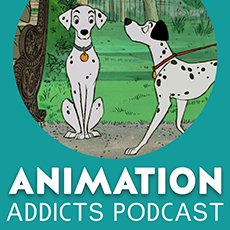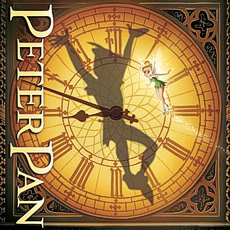Walt Disney Productions (January 25 1961), Walt Disney Home Entertainment (February 10 2015), 2 discs, 79 mins plus supplements, 1080p high-definition 1.37:1 original negative ratio, DTS-HD Master Audio 7.1, Rated G, Retail: $36.99
Storyboard:
When Anita and Roger Radcliffe’s none-too-welcome acquaintance Cruella de Vil learns that their Dalmatians Pongo and Perdita are about to be parents, she plans to buy them up and skin them all to make her demented dream of a Dalmatian fur coat a gruesome reality! When Roger rejects her offer, Cruella is furious, stealing the pups along with 84 other Dalmatians from across England, leading Pongo and Perdita on an adventure to track them down and save the pups from Cruella’s accomplices, Jasper and Horace, before it’s too late!
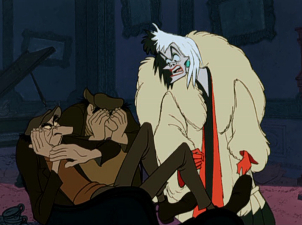
The Sweatbox Review:
You’ve got to love One Hundred And One Dalmatians (and not 101 Dalmatians as the marketing now has it – that’s the 1990s live-action film’s title), the 1961 animated feature that ushered in the pencil lined Xerox process and saw the animators’ original images transferred more directly to the screen. The film was something of a gamble: the lavishly produced Sleeping Beauty had proven an elaborate and costly film to make, and had not performed as previous Disney fairytales Snow White And The Seven Dwarfs and Cinderella had done, causing a bit of a headache for the Walt himself – namely, could animated feature films continue to be made as viable commercial endeavors? As had happened before, and would do again, there was a lot riding on the success – or failure – of this Disney outing.

The Xerox process provided a way for Disney’s films to stay contemporary and blend in with the growing trend for stylised, limited animation methods. Cartoon shorts had been going this way throughout the 1950s, led originally by the UPA Studio, and slowly the ethos of more simply designed characters, sharper movement (which required fewer images) and broader, emptier backgrounds (kept interesting by sometimes daringly used graphic representations of locations) also led to these shorts being cheaper to produce – an important cost cutter in the era that saw many cartoon studios going out of business. When it came to feature animation, another expense like Sleeping Beauty would have sunk anyone other than a Disney, but even he couldn’t gamble as much as that. It was down to Walt’s wizard extraordinaire and the man who on and off had been with him since the beginning, Ub Iwerks, to make their next project, an adaptation of Dodie Smith’s 1956 book, work on screen, and for a fraction of the usual price.

Beauty had been in production over six years at the Studio, eating up resources and guzzling cash – it was, at the time, the priciest animated feature made to date, complete with six-track stereo surround sound and widescreen 70mm to boot! That the film lacked Walt’s personal touch was evident (though it’s also fair to say that 1959 was not a record breaking year for any Hollywood studio), but what was true was that, as Walt had done after the ambitious Pinocchio and Fantasia both disappointed at the box office, the Studio needed a simple story that could be made quickly and economically. Not only did the Xerox process keep costs down, but it also aided the animators in not losing their heads keeping track of all the puppy spots they’d be required to animate!
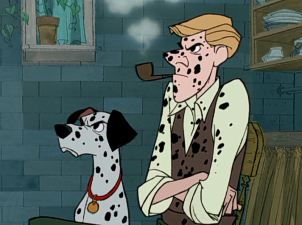
Iwerks had rejoined the Studio in the technical department (his freelance non-Disney work would also take in Flip the Frog for MGM and Alfred Hitchcock’s The Birds) and came up with the Xerox process, which copied the (cleaned up) animators’ drawings directly to cels, cutting out the need for an inker (which would sadly not be the last time a hefty segment of the animation department would be let go). There was still obviously a need for the painters to add color, but the system pleased the artists themselves, who felt their work was being preserved and finally presented in a more direct way, rather than having their drawings traced by the inkers. This produced a more “fluid” illusion of movement and gave great life to the images, though Walt wasn’t particularly pleased with the technique and remained reluctant to continue to use it until he saw it really was the only way to keep his beloved animation division alive.

The process meant the need for characters’ outlines to be burnt to the cel in solid black as opposed to the individually colored lines the inkers had been able to use, giving characters a sketchy look that needed rougher, somewhat grungier backgrounds. Ken Anderson’s production design for the film made the most of this: the layouts are among the most abstract in any Disney feature, with large blocks of color encompassing tinier details, props, architecture and furniture. Walt eventually grew to accept the look and it became a Studio trademark – I think it is what actually gives Dalmatians and the later Winnie The Pooh and Jungle Book their relentless, infectious energy, though it’s easy to agree with the old Mousetro that the approach is not best suited for the more traditional tales of The Sword In The Stone or Mary Poppins.
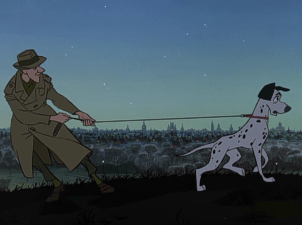
However, it was the way all the Studio’s films were produced up until the new generation of artists pushed for a way to return to the original way of creating animation, which finally came thanks to computer-assisted production where the artists’ refined drawings could be transferred and painted in the computer, allowing for the best of both worlds. With Dalmatians, style was of great importance. Due to the rough-edged look of the animators’ sketches, production design could not be too lush or as “deep” as the films of the 40s and 50s. Therefore, heavily “blocked out” backgrounds and layouts dominate the film, indicating to the audience that this is a new Disney, a different kind of Disney, with a modern look to fit the new decade. This approach serves the source material well – Smith’s original book sets the action in a contemporary world and this abstract, sometimes surreal setting is perfectly balanced with her words. This was, discounting Dumbo (whose circus setting provides its own old-fashioned feel in any case), Disney’s first contemporary tale, and is quite reflective of the thrillers and adventures Walt was making in live-action and for his Wonderful World Of Color TV show at the time.
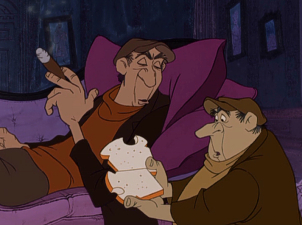
There are even a couple of great television gags: the puppies’ hero is a TV action dog (which a later direct-to-video sequel and a new short included in this Diamond package uses as a nice reference and set up nod), and a fun spoof of “guess my profession” styled game shows is titled What’s My Crime?, while an often made mistake is that the cartoon the pups watch in captivity is a black and white version of Flowers And Trees – in fact it’s the naturally monochrome 1921 Silly Symphony Springtime. Brimming with energy, wit and style, One Hundred And One Dalmatians is perhaps the most “modern” of Walt Disney’s original films and certainly atypical of what the Studio was otherwise turning out. The contemporary setting has not dated in the least, and there are no real pointers that the film was created in the “swinging 60s” apart from the animation process.
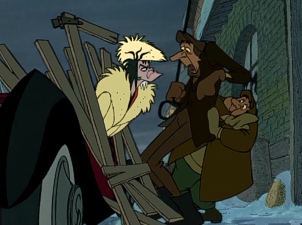
The script has real moments of poignant feeling (Roger’s life-saving Lucky is as low-key and dramatically realistic as they come), as well as some very funny supporting characters, and a big dose of high adventure. Betty Lou Gerson’s Cruella, along with Marc Davis’ tour-de-force visual interpretation, is one of Disney’s most classic villainesses (not until Robin Williams’ Genie would there perhaps be a better pairing of artist and vocalist) and her backups Jasper and Horace are among the most rounded of support players. Adding class is Rod Taylor as Pongo, who’d just scored a hit as the inventor in George Pal’s film version of H.G. Wells’ The Time Machine, and after his recent passing it’s great to hear those warm but solid tones again here. One nice trivia fact is that Ben Wright, who brings Pongo’s owner Roger to life, would later return to the Studio to portray Grimsby in The Little Mermaid!
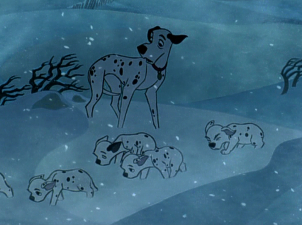
The story is tight too, faithful to the book (even if it does omit some characters) in a way that Disney never was with some of his earlier films and the later Poppins and Jungle Book. Because she’s not full of magic and after something very real and very cruel, Cruella also comes off as being one of the truly terrifyingly real Disney villains, which also helps the film elevate itself up from “mere” animated feature and into the lofty heights of pure modern-day cinema thriller. More importantly, there’s nothing really here that dates One Hundred And One Dalmatians, and given the resurgence in the Xerox look thanks to such projects as Ratatouille’s credit sequences and spin-off short Your Friend The Rat, and especially the Dalmatians-influenced work of Sylvain (Triplets Of Belleville, The Illusionist) Chomet, the film is still sharp looking today.
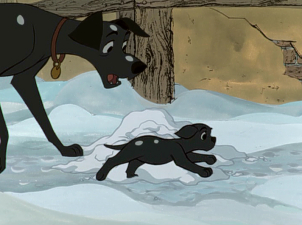
It was, of course, an instant hit on release, preserving the animation unit and allowing work to continue safely on films up until Walt’s death during The Jungle Book when it then fell to that film, and its successor The AristoCats to once again prove Disney animation could sustain itself. Although One Hundred And One Dalmatians should feel episodic in nature, it never is, as the main arc is so well played that the story does not have time to slow down, the suspense stretching to breaking point at times. Couple that with some absolutely terrific animation on some really well developed characters and something of an edgy, contemporary feel where the dangers are real and not just some cartoon, and you have one of Disney’s most enjoyable films from Walt’s or any other era. Forget the splashy but somewhat lifeless live-action remake (and its poorer sequel) and lap up this original animated classic!

Is This Thing Loaded?
A timeless perennial that was a big seller in the VHS days and on LaserDisc, One Hundred And One Dalmatians was a natural pick for Disney’s first forays into DVD, although the prospect of the “full color artwork on disc” and “interactive menus” of its initial Limited Issue disc didn’t even sound that promising even then! Since those times, we’ve had a direct-to-video sequel (the actually not too misguided Patch’s London Adventure supposedly itself due for a Blu-ray upgrade soon) and a reissue as part of the Studio’s supposedly prestigious Platinum Edition DVD line, which started promisingly but quickly degenerated into a line of so-so special editions, some certainly not deserving of any Platinum distinction. Much the same could be said with the company’s third time around and its Diamond Edition series, where last fall’s Sleeping Beauty offered much less than its previous Platinum sets! With Walt’s follow-up feature now making the same jump, how does this new Dalmatians scrub up? Top dog or spotty hound dog?
The main menu is a pretty basic affair, essentially being Pongo’s view of the street from Roger’s window, where the addition of Tibbs the cat watches the various pooches and their owners wandering by while Mr Radcliffe tinkles away on his piano. We don’t get the trivia track from the Platinum set, but for those nuts that like to “fill in the gaps” on the side of their widescreen displays, the Diamond-centric DisneyView feature will do this, courtesy of artist Mike Humphries, although as always I find the basic selection of imagery on the sides ultimately detracts, especially when there’s any camera movement and the sides remain oddly static, and although there is a bit of effort put into the coloring of these additions, the lack of variety still makes them feel tacked on (we’re still stuck with London houses even when visiting the park or the General’s farm, for instance, and the interior of Roger’s house when inside a country barn!).
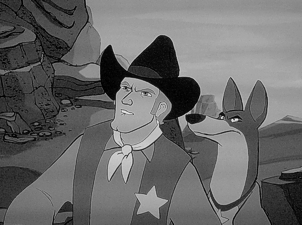
This release’s big new extra is The Further Adventures Of Thunderbolt short, but if you’re looking for a full ten minutes, or expecting even five minutes…or would be satisfied with maybe three…or even two minutes of new animated action, then you’re going to be sorely disappointed. At a whopping (note the sarcasm) one minute and forty-three seconds, this addendum to the Thunderbolt sequence the pups watch in the movie could have been something really cool. With Disney’s special projects’ Dave Bossert’s fingerprints all over it, none other than Disney Legend and Studio veteran Floyd Norman in the story seat and Phil Nibbelink on animation duties, the ingredients are surely here to come up with something that might have even set up a franchise spin-off in the form of an action TV show…but no – this plays mostly as a simple extension of the scene from the movie, complete with the puppy’s reactions lifted from the original film. In fact, even though there is still a bit of fun to be had, it all seems a little pointless at so short a length, with the recycling of footage from the film plus credits meaning there’s actually well less than a minute of fresh animation here…a very short short!
Lucky Dogs is a nice little tip of the hat to several artists who worked on the at the Studio in its later heyday, and particularly emphasises how important a film One Hundred And One Dalmatians was to the Disney Animation department. Among the more well-known faces making their comments are Burny Mattinson, Don Iwerks (and his hair) and Norman again, as well as Anita vocalist Lisa Davis, and this excellent little nine-minute piece makes great use of behind the scenes stills and, especially, some great title graphics that ape the feature’s title style.
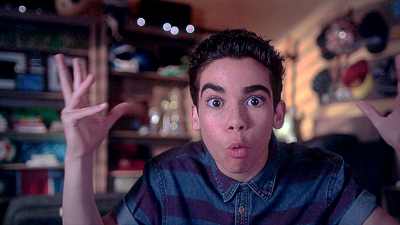
Hosted by Cameron Boyce (“son of Cruella” in Disney Channel’s upcoming The Descendants), Dalmatians 101 will split fans either way, being a “why the kids of today should find One Hundred And One Dalmatians cool” kind of thing. While a little unnecessarily too cool and desperate to get “da kidz” interested in the film, you’ll either find Boyce hugely annoying or his patter pretty amusing, and there’s some good sound-bite info in here, while the editing is energetic. Yes, against better judgement, I found this to be a flippant but fun five minutes!
In the days of his weekly television series, good ol’ Uncle Walt was essentially making behind the scenes specials even way back then, and although some of these shows cast awesome light on the production of any number of theatrical releases of the time, Walt Disney Presents: The Best Doggoned Dog In The World (1961 Version) is one of the more basically promotional examples. A full 51-minute edition of the show – in HD no less – directed by Robert Stevenson, long-time Disney dog fans may have seen the show before: it’s actually a repurposing of a 1957 episode that focused on Old Yeller’s production (and featured on that film’s Vault Disney DVD release), combined with a True-Life Adventure-style segment, Arizona Sheepdog, that makes up its second half. For Dalmatians’ release, Walt swapped out the Yeller sequences (for the sharp-eyed, the difference in Mr Disney’s appearance between the years make the changes clear) for a peek at his new movie, and although the introductory look at various breeds might feel somewhat prolonged, Walt stays with us throughout, so it’s a good value program.
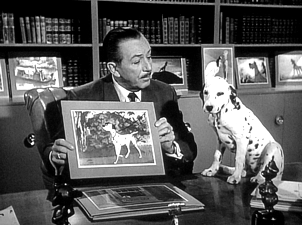
It is, however, almost 15 minutes before we get to discussing the main feature itself, and even then we’re only treated to around ten minutes of scenes from the film (essentially a potted telling of the story by Walt), while the second half, about quick-witted border collies in Arizona, will undoubtedly be a little too dry for today’s audiences. Unlike some previous Disney shows where the color sequences replace those from a given short or movie, here the Dalmatians clips remain as monochrome as the rest of the program, which otherwise looks decent enough if not spectacular in HD, which shows up all the print marks and evidence of many sequences being dupes from the previous incarnation of the same show. But whatever…Walt obviously enjoyed the sheepdog segment enough to run it twice in his series, and Rex Allen’s often witty narration, warm music and stellar scenery (if only in black and white) make for a cosy slice of nostalgia and even the credits reveal a faux pas in the widespread misspelling of “Dalmations”…!
That’s it for the “new” stuff, but there’s more to be found under the “Classic Bonus Features” banner, starting with the excellent Platinum Edition documentary Redefining The Line: The Making Of One Hundred And One Dalmatians. Broken up into several smaller featurettes, a handy Play All runs them together in a coherent 34 minute stream, covering everything from the publication of Dodie Smith’s book, storyman Bill Peet’s adaptation and the introduction of the Xerox process, to Marc Davis and Milt Kahl’s animation, the amazing achievement of shooting Cruella’s motorcar “for real”, and the public reception.
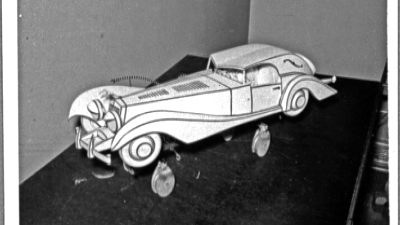
When these kinds of documentaries are done well, they really shine, and this one remains first rate. It’s also cool to hear that my personal views on the film are reflected from those who really should know what they’re talking about: such fans as Andreas Deja, Eric Goldberg, Brad Bird, Ron Clements and Don Hahn all praise the film with comments along the same lines as I’ve mentioned above. Once again as with the DVD, however, and still the most frustrating thing with this documentary is that the entire thing has been ported over from the 4:3 DVD in letterboxed widescreen only, including the matted film clips. There’s really no real reason for this: back on DVD I’d hoped that an eventual Blu-ray release would see it shown in its native HD dimensions, but this is a cheap cop-out, meaning that the entire program – plus the rest of the DVD-to-BD extras – are all displayed with a thick black border around the entire image.
It actually detracts from having such a wonderfully constructed and authoritative piece seemingly shoved into a second-tier treatment mode, and its treatment here, along with the other letterboxed DVD carry-overs, easily knocks a spot or two off the bonus score for the disc. The same visual treatment greets Cruella de Vil: Drawn To Be Bad, an otherwise terrific seven-minute stand-alone featurette that showcases perhaps Disney’s most successful villain of all time, and the talents that brought her to the screen (from author Smith, storyman Peet, animator Davis, and voice actress Gerson) are saluted, as well as Mary Wickes’ contributions via live-action reference.
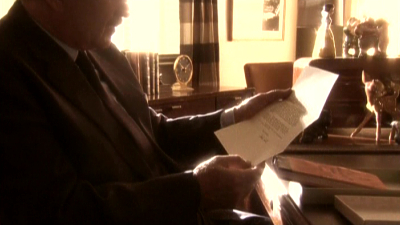
Sincerely Yours, Walt Disney focuses on original author Smith and her correspondence with movie producer Walt before, during and after the process of bringing her book to the screen. British Disney historian, the always great Brian Sibley, is the perfect narrator for this trip through archival photos, original letters and, most interestingly, “dramatic reconstructions” of imagined scenarios as the two creative forces “speak” through written words. It’s a nice idea, fairly well brought to life, and “authentic” down to having an appropriate stand-in for Walt’s secretary Hazel George, and although the actor doubling Walt doesn’t have quite the right kind of vocal intonation that Corey Burton captured so genuinely in the “Story Meetings” recreated for the Platinum Edition of Bambi, at least this piece isn’t solely restricted to being windowboxed within the 16:9 frame for its entire length. A very insightful supplement (running well over 12 minutes), even more so because it seems Smith wasn’t an active participant in the production and eventually only saw it in final form at a private screening in London, it’s things like these – really nicely thought out, filmed and edited – that make up the differences for aficionados.
Also making up for the lack of extensive Studio documentation is a welcome holdover of a pretty extensive series of theatrical Trailers and TV Spots! Mostly an absent feature on Disney’s Blu-rays nowadays, it’s almost a case of welcome overkill here, with three teasers and trailers for the original 1961 release (including an early CinemaScope print) and four spots for the 1969 reissue (including one as an exciting double bill with Swiss Family Robinson). The 1979 reissue brings further four trailers and TV spots (one a French Canadian oddity with a pretty spooky voiceover), while 1985 has to make do with one preview, and the terrific 1991 release still unfortunately goes amiss, meaning those with their Limited Issue discs still have a reason to keep that edition. Now in their own section, Radio Spots include three for 1961, six for 1969 and three for 1979, the two best being 1969’s “R&B Version” (with a brief chance to hear the 1960s pop version of Cruella de Vil) and the almost bonkers “adult Detective” spot from 1979 – all great fun!

While the “Music & More” heading might sound rather basic, there’s a wealth of material hiding inside, including the Platinum Edition’s Selena Gomez Cruella de Vil music video, running a boring three and a half minutes in 4×3 video, for what it’s worth. In the huge library of classic Disney song music, Dalmatians composer Mel Leven is often overlooked, despite Cruella de Vil perhaps being one of the most covered of all Disney tracks, but this take brings little new to the party, and it’s even a bit confused, seemingly taking the 1990s live-action version as an inspiration point. But maybe I’m mellowing: while I felt the now-younger Gomez was pouting like a precocious over made-up six or nine year old on the DVD, here I actually enjoyed the track more, even if I’d still have much preferred to have seen and heard any of the previous versions of the song that have been commercially released.
With The March Of The One Hundred And One (Deleted Song Sequence) we begin to hear the musical progression of Dalmatians, both from songwriter Leven’s own intended songs and those from other composers’ earlier versions. This one, from Buddy Baker and Tom Adair, looks like it came extremely close to inclusion going by the retained pages of contextual information, but was rightly cut to maintain dramatic tension, while a further series of Abandoned Songs presents two additional cuts: Cheerio, Good-Bye, Toodle-oo, Hip Hip! was written earlier by Leven for a similar situation in the movie, and Don’t Buy A Parrot From A Sailor is a song moment for the Badduns, Jasper and Horace. Demo Recordings And Alternate Versions offer up extended cast and temp recordings of Dalmatian Plantation and – real highlights – multiple alternates for Cruella de Vil: Spooky and Blues Ballad demos, “Roger” takes, unused Honky-Tonk piano underscore, and even three alternate “Radio Hit” versions! Lastly, there’s the chance to hear nine different vocal approaches to the Kanine Krunchies jingle in a variety of accents and styles, all performed by Lucille Bliss. With the majority accompanied by appropriate storyboard art, this is a terrific delve into the archives to hear how much attention was lavished on Dalmatians’ musical score.
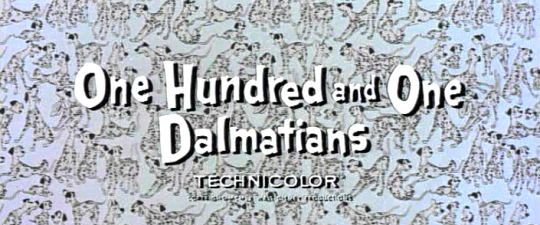
The disc rounds out with the usual bunch of previews and Sneak Peeks, either playing at the top of the disc or optional from the menu, with trails for Disney Movies Anywhere, Aladdin’s long delayed arrival in the Diamond line (“the wait is finally over”), Cinderella (what’s with the glass slipper teaser when the movie is just over a month away and we’ve had two further full trailers!?), Disney Channel’s Dog With A Blog, Star Wars: The Clone Wars’ Lost Missions, Big Hero 6, Tinker Bell And The Legend Of The Neverbeast and a Dalmatians-themed anti-smoking announcement which is presumably the Studio’s way of neutralising the chain-puffing villainess of the film.
What’s Missing? With the jump from DVD to Blu-ray, many of Disney’s titles have seen too much previously available supplemental material fall by the wayside, and although the Diamond Editions should in theory provide the ultimate experience, each new title reveals that just as much is taken away as much as something new is added. The Platinum DVD for Dalmatians was ostensibly a hastily-assembled affair, so we can be pleased that at least this Diamond Edition has had a little more thought put into it, but there are still omissions that I at least know of, and apart from a potential commentary track, the original Limited Issue disc also included an additional 1991 reissue trailer which again has no reason to be absent here.
There was also a good BBC documentary that aired in the UK about the life of book author Dodie Smith which heavily focused on Dalmatians both as her most successful book and the production of Disney’s film, also touching on her friendship with Walt and which would have made a perfect compliment to the correspondence feature included. From the Platinum DVD, a couple of lost games aren’t a worry, but we’re missing a pair of solid pop-up trivia tracks, and a usual casualty is the sadly now not-surprising lack of any Stills Galleries, seemingly too much of a burden for the Studio to bother porting over to HD. Would these images need to be scanned again? Surely they were captured at high-resolution to begin with? Is it a case of not wanting to set up presentation templates again?

Whatever the reasons, it’s a shame that such galleries have become a no-show on Blu-ray in general, and Dalmatians had an extensive selection from its development, designs and layouts to its live-action reference and general production photos, amounting to a generous helping of around 250 images that were hardly touched in any of the documentary material and so presenting a lot of rarely seen stuff that was ripe for studying. However, that being the case (and with all good Disney fans no doubt holding on to their original DVDs!), the supplements that are retained from the Platinum set and the new extras here are all so well produced – especially the documentary and correspondence featurette – that one can somewhat forgive these oversights, and the inclusion of the theatrical trailers and extensive catalog of music recordings makes this one of the better Diamond discs to come along in recent times.
Case Study:
Long gone are the days of lavish book and disc packages of the kind that the early Platinum Editions and even One Hundred And One Dalmatians’ DVD enjoyed in some countries, and although the Diamond Editions haven’t done all they can to remain consistent, at least there’s been a trend of late to present a similar design across more recent titles. The bordered look didn’t suit The Jungle Book, to be sure, and it was dropped again for Sleeping Beauty, but here it suits Dalmatians quite well, the glossy silver making for a nice background to the off-white Pongo, Perdita and the pups. Most annoying is the continuing insistence to call the film “101 Dalmatians” instead of Walt’s original full title, but this is otherwise one of the nicest Disney sleeves in a while. Inside, there’s a DVD copy included but there’s no Diamond booklet to announce Aladdin…just a regular Movie Rewards code and Movie Club insert, making it not so special after all.
Ink And Paint:
Just as the Platinum DVD presented One Hundred And One Dalmatians in its 1.37:1 negative ratio, so does the Diamond Blu-ray, running up another anomaly transfer for a Disney animated film. Why the big deal? Well, if any of Disney’s open matte features deserves to be seen in a wider ratio (or at least its European 1.66:1), it’s Dalmatians, intentionally animated for a cropping of the Academy framing for wider theatrical dimensions and further providing another level of a contemporary feel in the theaters of the time and indeed on our screens today (and as seen in most of the clips in the extras).

Other than that, the actual transfer does look, well, spotless, and the only thing that could be seen as a distraction in this version are the overly bright colors. Missing lines and a digitally scrubbed look that plagued The Sword In The Stone isn’t any kind of issue here, such is the good work of the restoration team, and even One Hundred And One Dalmatians’ original Buena Vista title card is kept in place for the purists.
Scratch Tracks:
With an Enhanced Home Theater Mix originally presented on the DVD, a similar DTS track, bumped up to 7.1 here, is generally pleasing, essentially being based on the 1990s theatrical re-issue, when Randy Thornton was making the most of a company-wide effort to preserve its archival elements. A well-balanced mix that does little to vary wildly from the 1961 studio recordings, there’s a bit more separation in George Bruns’ music, freshly remixed at the time from then-newly found stereo elements. Voices are locked centrally and come across without distortion, and the surround track gets a little more of a workout than most other classic film remixes, even if Dalmatians is, as a thriller, more interested in smaller, dramatic moments and dialogue rather than all-out action scenes.
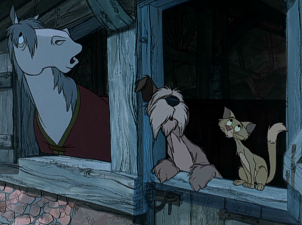
French and Spanish dubs have also been included (which have decent fidelity and, as usual for Disney, well performed foreign character translations), as well as an “Original Theatrical Mix” offering a cleaned up edition of how audiences would have heard the film in 1961 mono. English subtitles have also been included.
Final Cut:
Easily one of Disney’s most enjoyable films, One Hundred And One Dalmatians is modern thriller moviemaking on a classic animated scale. While the numerous stills galleries are the big omission here, there has been at least a bit of thought and effort put into the new supplements here and the retained extras remain engrossing and plentiful. For a film that was ostensibly made to a budget and intended as much as a “quickie” as an animated film could ever be termed, Dalmatians plays like one of those rough and ready but brilliant 50s crime movies (it even starts with a voice over), but done in animation and color! One of the Studio’s least dated classic films, One Hundred And One Dalmatians is ultimately top drawer Disney, and it gets a pretty solid treatment in the Diamond line. A commentary wouldn’t have gone amiss, nor the inclusion of the film and the “classic” extras in true widescreen but, these caveats aside, this hits the spot perfectly.
 | ||
 |




